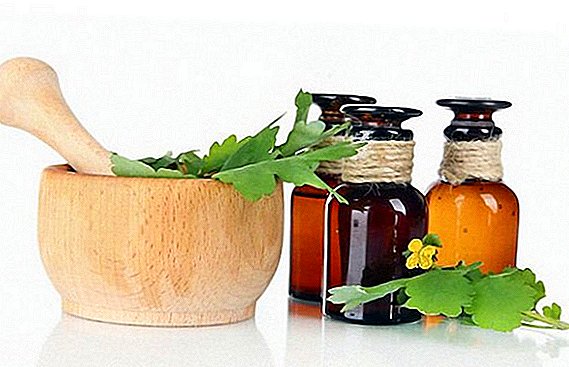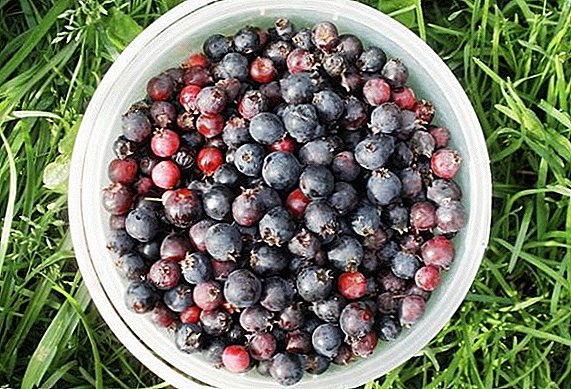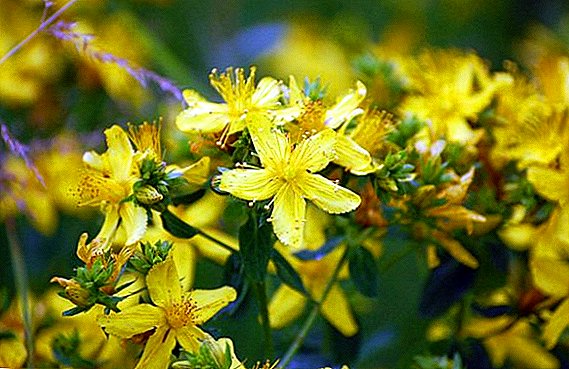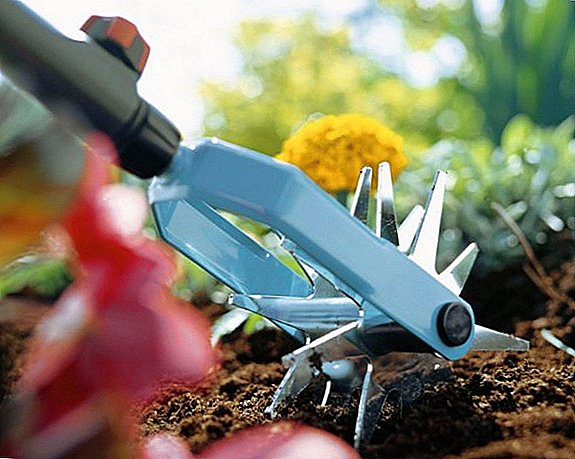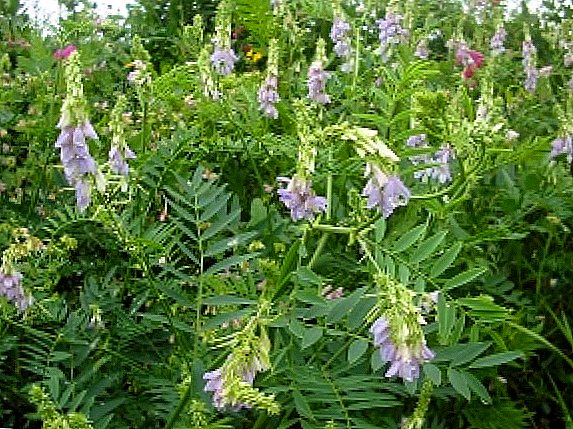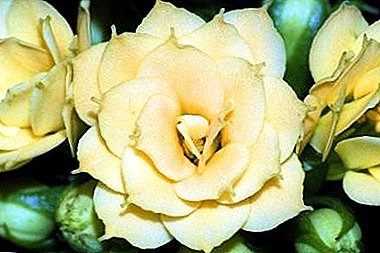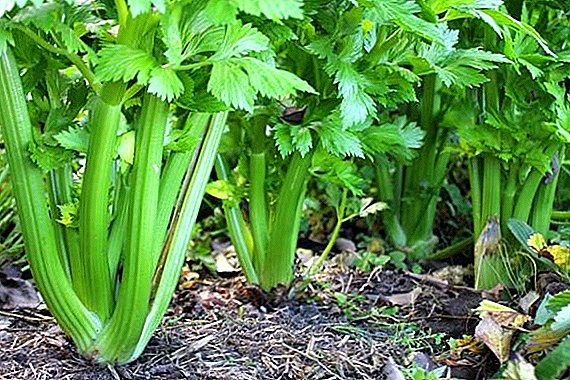 People appreciated the aroma and taste qualities of celery not so long ago: this plant has been used in cooking for several centuries, although references to it are dated back to ancient Greek chronicles; in antiquity, it was valued only as a medicine. Nowadays, many supporters of healthy and healthy nutrition are engaged in growing celery in private plots. In this article you will find useful tips that will facilitate this lesson.
People appreciated the aroma and taste qualities of celery not so long ago: this plant has been used in cooking for several centuries, although references to it are dated back to ancient Greek chronicles; in antiquity, it was valued only as a medicine. Nowadays, many supporters of healthy and healthy nutrition are engaged in growing celery in private plots. In this article you will find useful tips that will facilitate this lesson.
Botanical description of celery
Celery fragrant, it is cultivated, is the most famous species of the Celery family of the Umbrella family (Celery). The plant is 2-year-old, it can be grown for one year to obtain greenery or rhizomes, and in the second it is left for flowering in order to obtain seeds. The herb has simple and pinnately dissected leaves. It reaches a height of not more than 1 m. During flowering, small inflorescences, simple and complex umbrellas appear on the tops of the stems.  The fruit of the plant is achene. Celery is taproot, but it has a peculiarity of forming a thickening - a root crop. Celery is propagated by seeds, but their germination period is quite long, so the best solution is to grow seedlings. When buying seeds in the store, there is no possibility to control the freshness of seed collection.
The fruit of the plant is achene. Celery is taproot, but it has a peculiarity of forming a thickening - a root crop. Celery is propagated by seeds, but their germination period is quite long, so the best solution is to grow seedlings. When buying seeds in the store, there is no possibility to control the freshness of seed collection.
Important! If the seeds are collected independently by hand, then you should be aware of the fact that over time their germination improves. So, for example, seeds collected a few years ago will grow faster than those collected at the end of last season.
Celery is usually divided into 3 varieties:
- leaf - grown for the sake of fragrant greenery, the season of cutting leaves lasts from late spring until the end of autumn;
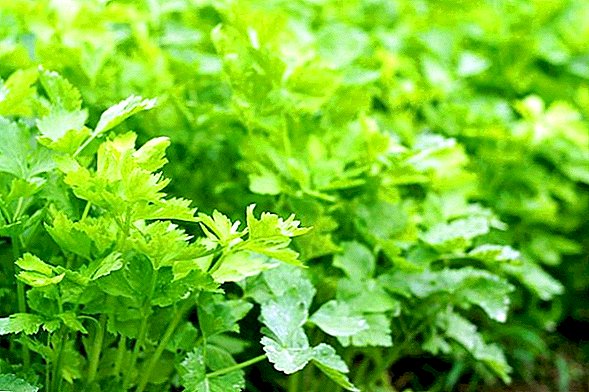
- petiolate - grown to produce petioles, which are harvested at the end of the summer season;
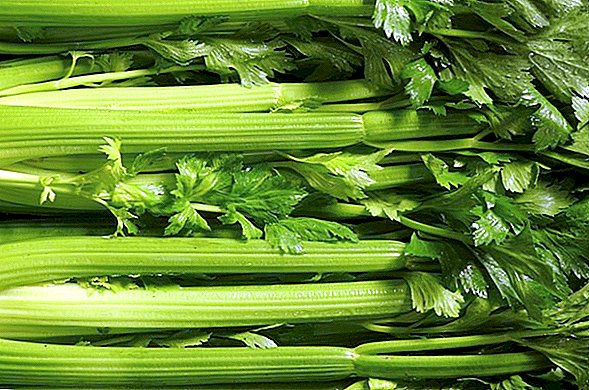
- root - grown for the purpose of harvesting root vegetables, which grow to the beginning of autumn and reach a mass of 400-800 g.
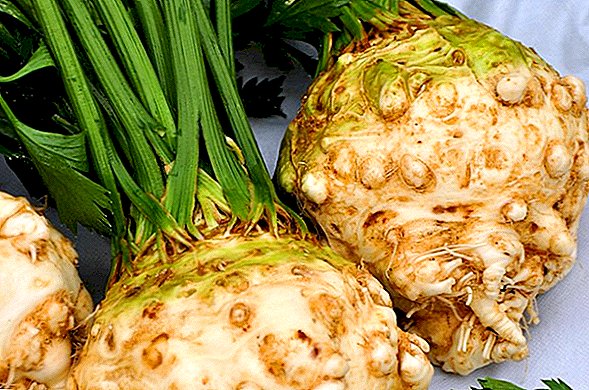
The leaf species can be grown in the northern regions, since its growing season is the shortest. Root takes more time, so it is grown through seedlings. All varieties of celery are grown in moist soil.
The optimal time for growing
Considering the question when to sow celery, it is necessary to remember that the best way to grow this vegetable in our latitudes is the seedling method. Sowing material is sown in boxes for seedlings in February. Transplanted seedlings, which have grown enough, on the garden in April or a little later, depending on the region.
Did you know? The favorite and courtesan of the French king Louis XV, who reigned in the 18th century, Marquis de Pompadour, preferred celery in the diet because he helped her to be more attractive, eliminating frigidity, and had a passion for the king, which she fed with soup from this plant .
Where is the best place to put celery
You can grow this culture in the country with other vegetables in the rows or next door to planting:
- potatoes;
- cabbage;
- cucumbers;
- garlic;
- Luke.
Lighting
Celery grows well in sunny areas and in partial shade. An abundant amount of light enhances the already strong aroma of the greenery of this plant.
Temperature and humidity
This culture can be grown at sufficiently low temperatures. Seeds are able to germinate at + 3 ° C, optimal for growing + 15 ° C. Seed shoots can tolerate small frosts, lowering the temperature to -5 ° C. Celery likes high humidity. It requires frequent watering, due to which the soil is constantly wet. 
Soil requirements
Celery requires soil, which will have the following characteristics:
- light, breathable;
- high in nutrients;
- neutral or weak acidity.
Planting celery in the open ground at home
It can be grown by sowing seeds in open ground in warmer, southern regions, or by seedling in the area where strong frost on the ground is still possible in March-April. Seedlings are sown on seedlings in February - March, then shoots appear only a month later. Agrotechnology consists, first of all, in carrying out stratification or seed treatment for their improved germination.
Important! Stalked celery spud before harvesting, and the root spud it does not follow.
To do this, the seeds are wrapped in wet gauze and left in it for a week, controlling the drying of matter, after which they are sent for 2 weeks in the refrigerator, to the compartment where the air temperature has the lowest rate. The treated seeds are immersed in the prepared substrate, which consists of peat, humus, turf and sand.
Also fertilize the soil with urea and wood ash. The soil is abundantly moistened before sowing the seeds, then they are deepened by no more than 0.5 cm. The container is covered with a film and left in a room with a temperature comfortable for humans + 20 ... + 22 ° C. Before sprouting shoots, it is necessary to carefully monitor the soil moisture and irrigate the surface with distilled warm water. After their appearance, the temperature should be reduced to + 13 ... + 16 ° C.  After the appearance of the first leaf on the seedlings, it begins to swoop. This process should be carried out with special care to prevent damage to the rhizome. Properly performed picking will allow to grow a large root vegetable. 2 weeks before transplantation into the open ground, seedlings begin to harden, bringing it to fresh air, for a start for a few hours, and bringing the duration of being in the open air to a day.
After the appearance of the first leaf on the seedlings, it begins to swoop. This process should be carried out with special care to prevent damage to the rhizome. Properly performed picking will allow to grow a large root vegetable. 2 weeks before transplantation into the open ground, seedlings begin to harden, bringing it to fresh air, for a start for a few hours, and bringing the duration of being in the open air to a day.
Did you know? In ancient Greece, wreaths from celeryI put them in the place of the burial of a person, because they symbolized an offering to the gods of the realm of the dead, where the soul of the deceased was later sent.
If you have the opportunity to purchase ready-made seedlings, then you should pay attention to such criteria, which will be a sign of quality planting material:
- seedlings should grow to 14-15 cm;
- the root system must be formed and sufficiently developed;
- must have a few leaves.
Seedlings are transferred to the wells with a small amount of organic fertilizer and deepened to the cotyledonary knee. Then make watering and pritenyut wet paper.
Care features
It is easy to care for celery, it is only important to observe some steps:
- weeding, weed removal;
- soil moistening and moisture maintenance;
- loosening;
- introduction of nutrients.
 However, it is worth noting that different types of celery have some individual characteristics in the process of growing. For example, to accelerate the growth of the root species, its leaves are pressed to the ground, which leads to the appearance of cracks in the cuttings, but does not harm the root.
However, it is worth noting that different types of celery have some individual characteristics in the process of growing. For example, to accelerate the growth of the root species, its leaves are pressed to the ground, which leads to the appearance of cracks in the cuttings, but does not harm the root.Thinning and soil care
The condition of the soil plays a significant role in the cultivation of celery. Since the plant needs a moist and nutritious soil, it is necessary to ensure the loosening of the top layer of the earth after each irrigation, so that the soil remains fluffed and the air has access to the rhizome. In addition, the appearance of weeds in the garden can reduce the amount of nutrients that celery will get.
Learn about planting and caring for celery in the garden.
Therefore, they should be systematically removed, controlling their appearance at the initial stage. Special attention should be paid to the petiolar form 2-3 weeks before its maturation and the planned collection. For him, experts recommend the procedure of hilling or sticking the ground to the bottom of the plant.
This technique provides the following benefits:
- petioles become white;
- the amount of essential oils becomes lower;
- bitter taste of celery is felt less.
 There are secrets that will help grow a larger crop of root crops, respectively, of the root celery. To achieve such a result, the tuber tips are partially cleaned from the ground. In addition, the root crop already grown by mid-summer has small roots in its upper half, which are removed after it has been opened.
There are secrets that will help grow a larger crop of root crops, respectively, of the root celery. To achieve such a result, the tuber tips are partially cleaned from the ground. In addition, the root crop already grown by mid-summer has small roots in its upper half, which are removed after it has been opened.Watering
Moisturizing should be systematic. Do not allow the appearance of crusts on the soil surface. To preserve moisture, experts recommend applying soil mulching immediately after transplanting plants into open ground.
For this purpose you can use:
- peat;
- sawdust;
- mowed grass.
Read also about popular varieties of celery.
Fertilization
Preparation of soil for planting celery is recommended to begin in the fall. The soil at the site is fertilized without chemicals, using humus. This organic supplement should provide spring nutritional value of the soil. In the process of planting seedlings, a small amount of humus and ash is added to each well, and the soil is treated with Trichodermin solution. When the seedlings are already planted at a permanent place of cultivation, the application of mineral fertilizers in 1.5 weeks should be included in the feeding schedule. For these purposes, it is recommended to use nitrophoska diluted with water. 
Harvesting and Storage
The gathering season of stem and root species occurs at the end of summer - the beginning of the autumn season. For 15-20 days, preparation for this process begins. It consists in removing the foliage from the plant. Crop from a leaf variety is harvested as much as it grows, that is, as long as the plant has attractive and abundant greens. Gardeners even recommend moving it to the premises for the winter: to do this, you need to dig up the root with a small earthy clod and transplant it into a suitable pot.
We recommend that you learn about the features of the celery harvest.
Store petioles should be in aluminum foil in the refrigerator, after they have been well washed and dried with a towel. The leaves of this fragrant herb can be stored in the same way, or put in a container with water, after cutting off the rhizome. Celery tubers in the conditions of home storage are thoroughly washed and sent in a plastic bag to the vegetable compartment of the refrigerator.  If we are talking about a private house and in the presence of a basement, then the roots can be stored by digging them into a box with sand. Celery has a lot of useful properties, so more and more people are interested in growing this plant at home. It is important to remember the characteristics of each variety of vegetables for a good harvest.
If we are talking about a private house and in the presence of a basement, then the roots can be stored by digging them into a box with sand. Celery has a lot of useful properties, so more and more people are interested in growing this plant at home. It is important to remember the characteristics of each variety of vegetables for a good harvest.





